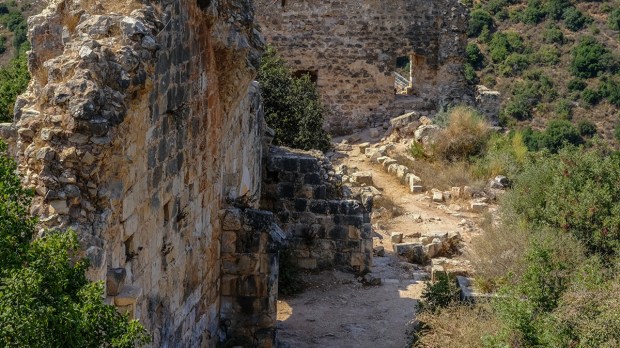A Crusader-era castle in Northern Israel is providing insight into construction methods of its 12th-century Frankish builders. The work is proceeding under a unique agreement between Mi’ilya, the town where the castle is located, and Israel Antiquities Authority. The IAA is allowing Mi’ilya to excavate its own historical sites, which is practically unheard of in Israel.
The excavation effort is led by archaeologist and educator Rabei Khamisy, who was born and raised in Mi’ilya. The report from Haaretz notes that Khamisy knows the site better than most, as he and his friends used to explore every nook and cranny in their youth. A now graying Khamisy recalled how they would insert a ladder into a particular darkened shaft and climb down as far as they could go.
Now, as an expert, Khamisy has identified that this darkened shaft actually leads to a cistern, and he has since discovered two more. The shaft he and his friends played in reaches from the top of the wall down to a cistern carved into the bedrock. Another shaft begins within the castle, in a room that has been redesigned to accommodate guests as part of an effort to refit the site as a hotel.
Pipes and water buckets
In this room, which now is fully equipped with a television and other 21st-century creature comforts, visitors can still peer down into the hole, now fenced off for safety’s sake. This is where the revelations about Frankish architecture came into play. Khamisy noted that the shaft must have been planned all along, since the bricks were formed to accommodate ceramic pipes.
These pipes direct rainwater into the cistern, which can be drawn in bails for later use. Thepipes spanned multiple floors that can be accessed from various points. In another unique design, each floor bears a notch in the ceiling near the well.
It is believed that a pole was fastened in the notch, which connected to an arm that could swivel in order to position the water bucket over the hole to be lowered in. This would ensure that buckets from the lower floors would not impede those of the upper levels when not in use.
“It’s amazing! You can find something here or there, but this is complete. You have the shaft, you have the pipe, you have the entrance to it, you have where they took the water. It’s just a little bit damaged,” Khamisy says. “It’s the best place to work on water systems in the Crusader period. This is heaven for this research.”
Town excavating itself
It is unusual that the IAA would allow an historic site such as this to be turned into a hotel, but it comes as part of their agreement with Mi’ilya. Haaretz explains that IAA did not want to cover the $3 million cost of excavation, but the town was able to raise the funds. With the citizens taking care of expenses, they have been allowed a great amount of freedom to take charge of the excavation, although the IAA still sends out representatives to ensure the work is being properly undertaken.
That the agreement exists at all comes thanks to Salma Assaf, a local entrepreneur. In 2019, Aleteia reported on Assaf’s endeavor to excavate and preserve the largest Crusader-era winery ever discovered, in her restaurant basement. Assaf is currently working with IAA to turn the winery into a museum, which could open as early as April.
As with IAA’s agreement with Assaf, the town of Mi’ilya will retain the rights to the castle, as it is privately owned by citizens of the town. In exchange, IAA will get to watch as another historical landmark is unearthed, at no charge to them, and enjoy whatever discoveries are made. While IAA is normally aggressively protective of the nation’s heritage sites, they decided that the excavation of the castle in Mi’ilya was important enough to make an exception.
Read more about the unique archaeological operation in Mi’ilya and its discoveries at Haaretz.

